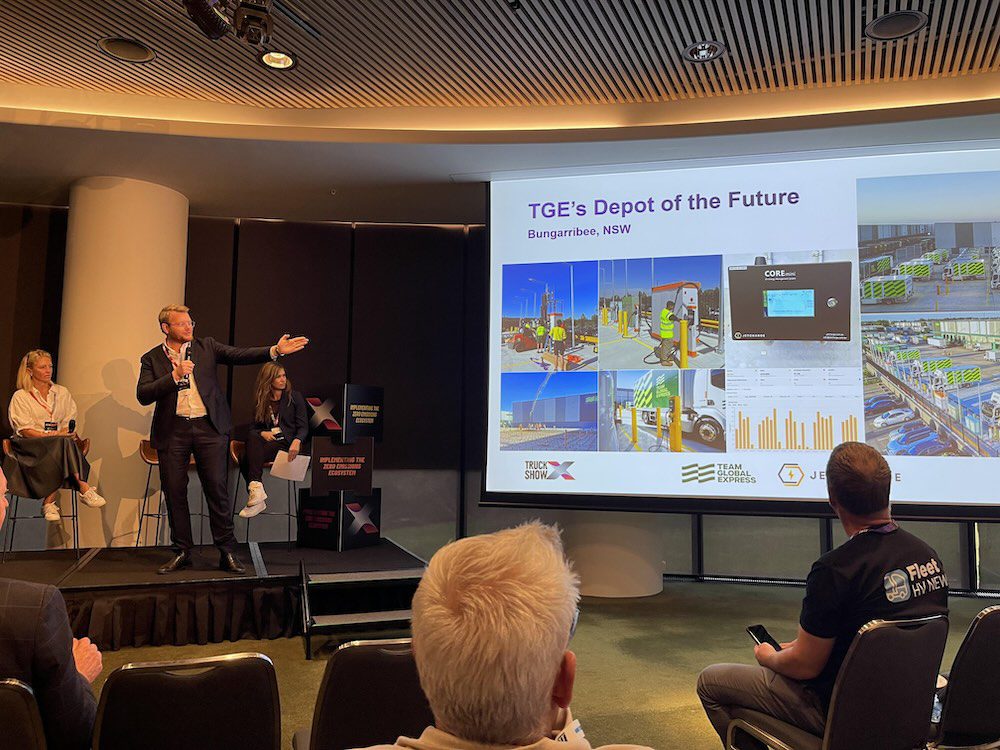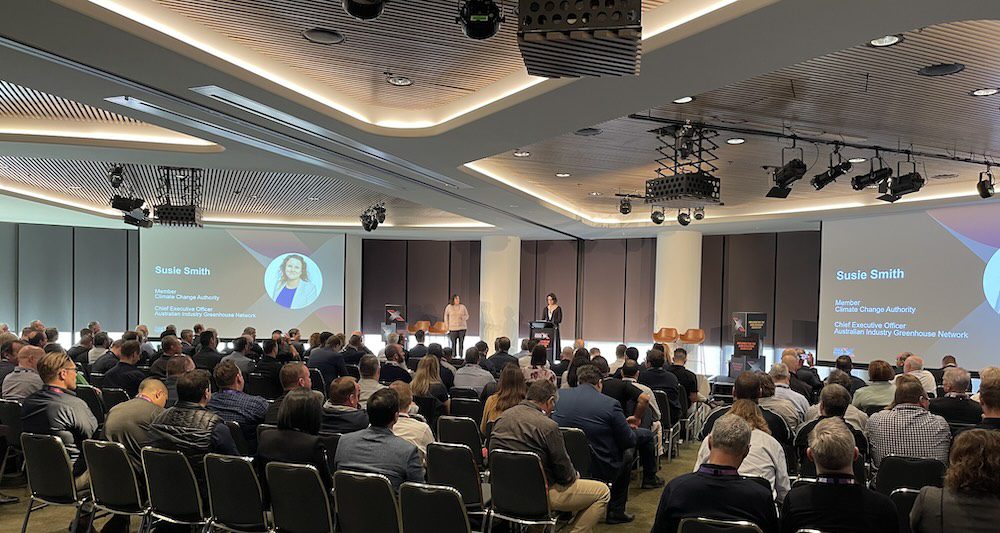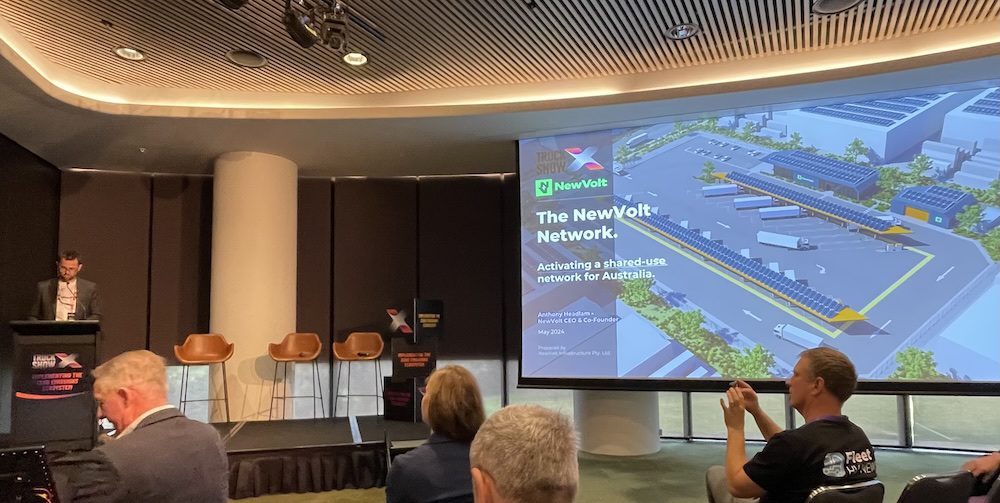The first electric truck show in Australia was held over two days last week, and one of the standout sessions was an hour long Q&A with Heather Bone from Team Global Express and Alex Bowler from Jet Charge.
They provided some fascinating insights into TGE’s new $44 million electric last-mile delivery hub, recently launched by the Prime Minister in Western Sydney, which includes a fleet of 60 fully electric last mile delivery trucks, battery storage and rooftop solar, and some astonishing savings from grid costs.
The project, backed by $20 million from ARENA (the Australian Renewable Energy Agency), has supported the cost of the trucks, the 63 chargers, a 1 MWh battery and a 400 kW solar system at the depot.
“We’ve got 400 kilowatts of installed solar capacity and we have a one megawatt battery. We play with the spot market with our energy and so this site is often down usually at about two to five cents per kilowatt hour,” says Bone.
“If there is a peak though, and we can kick in the battery so we basically turn off from the grid and kick the battery. Last week on Thursday, we saved $17,000 in one hour.”
“Imagine doing that, imagine that operational impact every time we kick in that battery to try and arbitrage the market. At the moment that’s a fairly manual process in order to take advantage of it. But as soon as we do it, we are saving a huge amount of money. I would actually say we are not using these trucks anywhere near as much as we need to be using them.”

Alex Bowler from Jet Charge provided some more technical insights into the Australian first project.
“There’s two charging areas. One at the top with the 47 AC chargers and then there’s 16 high powered Kempower DC chargers in this other charging area on the other side of the site,” said Bowler.
“There’s 800 kilowatts of charging power installed there in total. And one of the challenges that we had during the build was trying to find a way to get all of the energy that the trucks needed from the site or from somewhere. So how do you go about doing that from a clean slate?”
“Ways in which we were fortunate on the project, on the site that TGE has are two really large transformers that didn’t have a whole lot of running capacity on them. So we’re able to pull each charging area essentially off each transformer or some subset of the electrical distribution on the site and then run power out to charging.”
Attendees of Australia’s first zero emission truck show, Truck Show X, have praised the conference as a huge success in seeding new connections and sparking conversations about the future of Australian trucking.
The conference – held at Cape Shank in southern Victoria, and hosted by industry group Heavy Vehicle Industry Australia (HVIA) – drew hundreds of attendees who heard from a number of speakers on topics ranging from battery electric trucks and truck charging infrastructure to government funding opportunities as well as updates on policy directions.
Other speakers at the conference included E-mobility Solutions Manager at Volvo Group Australia Tim Camilleri, General Manager at Eurocold Revora EV Nathan Gore-Brown, and Chief Advocacy Officer at HVIA Dr Adele Lausberg.
It also heard from representatives of government agencies, including Susie Smith from the Climate Change Authority and Ian Porter who is the First Assistant Secretary Net Zero for the federal Department of Infrastructure, Transport, Regional Development.

NewVolt share’s plans for an Australian electric truck charging network
Another standout session during the conference came from the CEO of NewVolt Anthony Headlam, who laid out the case for an Australian electric truck charging network.
“When it comes to the transition for the road freight sector, we believe Australia is different,” Headlam told attendees.
“Fundamentally, the decarbonising growth rate in any country requires two things. Energy that can power trucks without carbon emissions and infrastructure that can deliver that green energy as cheaply and efficiently as possible where and when trucks need it.”

Headlam argued the case that Australia has a unique comparative advantage thanks to its relatively simple yet high-density freight corridors as well as its access to abundant cheap renewable energy resources.
“The entire world is on a decarbonisation journey. Each jurisdiction is considering the mix of technology that can help achieve this and how quickly to get there. Our starting point for that same discussion is that Australia is different. We have fundamental comparative advantages that should be kept front of mind,” said Headlam.
“Firstly, Australia has abundant renewable energy resources and I appreciate, in this buzz around the energy transition that this can feel like a cliche because we hear it so often. But we shouldn’t forget it because it is true. Neither Europe, the US nor most of Asia have the same renewable energy resources that we do nor land or the big rooftops to harvest them.
“It absolutely requires technology and engineering smarts to capture the benefit at lowest cost, and this is the hard bit, behavioural change and operational changes to optimise it.
“Put simply, the sun doesn’t always shine and the wind doesn’t always blow. We are operating in a different energy system and if you want to capture the benefits of that different energy system for this sector, it is going to require some operational changes that will accept that that is difficult.
“The second reason Australia is different is our road freight network. When thinking about the scale of the infrastructure challenge in terms of accessible charging for heavy vehicles, the fact that Australians choose to live close together in southeast Queensland in Greater Sydney in greater Melbourne and a few elsewhere is actually very helpful.
“This means that electrifying corridors, intermodals [train freight hubs] and industrial precincts for the lowest hanging, highest volume 80 or 90% is very possible with the technology here now, and coming soon without it being at vast expense.
“Again, this is really important and not the same if we were looking at a map of Europe or the US. So the NewVolt network was born out of this context, the fact of Australia’s renewable energy advantage and the fact that a national charging network for trucks is achievable. That is what we want to do.”
After successfully bringing together the trucking industry, government representatives and clean transport experts, Truck Show X may be the catalyst for change Australia’s road freight industry has been waiting for.
HVAI says it’s “quite exhilarating” to see transition happening fast
At the end of the two-day conference, The Driven sat down with the CEO of HVIA Todd Hacking to discuss the feedback on the event and how the Australian trucking industry is currently positioned regarding the transition.
“This is without doubt, the biggest and hardest step change for the industry in over 120 years.” Hacking told The Driven.
“So it would be nice to plan it, it would be nice to structure and coordinate it. It’s also quite exhilarating to see it happening so fast. It’s this melting pot of innovation and tech and commercial and that’s really cool and it’s exciting to see.”
“You can feel the buzz in there, you can feel the energy and it’s super cool to be involved.”

Daniel Bleakley is a clean technology researcher and advocate with a background in engineering and business. He has a strong interest in electric vehicles, renewable energy, manufacturing and public policy.


